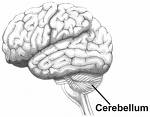 How and why humans became bipedal has been the subject of much debate. There still isn't a single theory that is accepted. Some think we stood up to stay cool (less body surface exposed to the sun), that walking upright allowed us to travel long distances more efficiently, enabled us to spot predators, use tools, carry food, babies, etc.
How and why humans became bipedal has been the subject of much debate. There still isn't a single theory that is accepted. Some think we stood up to stay cool (less body surface exposed to the sun), that walking upright allowed us to travel long distances more efficiently, enabled us to spot predators, use tools, carry food, babies, etc.What we do know for certain is that walking bipedally coincided with a change in where our spinal column enters the skull (through a "big hole" called the foramen magnum). All other primates have a spinal cord that attaches to the brain at about a 45 degree angle; a human's does so at about 90 degrees.
 This shift also altered the way the throat muscles and vocal tract are situated, giving humans an ability to utter a wider range of sounds than other primate. Thus, walking bipedally could ultimately be responsible for why humans have speech and language.
This shift also altered the way the throat muscles and vocal tract are situated, giving humans an ability to utter a wider range of sounds than other primate. Thus, walking bipedally could ultimately be responsible for why humans have speech and language.The program interviewed some scientists about whether they thought this family could provide some clues about the evolution of upright walking. Of course they can! One thought they could if the afflicted people had a genetic abnormality that kept them unable to walk upright. I think it could be that this hypothetical genetic sequence, or one nearly like it, is actually normal for other primates whereas humans carry a mutation.
 Another scientist thought this family suggests nothing about the evolution of bipedalism because the kids learned to walk on all fours in response to a cerebellum problem. They have "cerebellar ataxia," a condition that can be congenital but also can develop in response to a virus, in which case the condition tends to resolve itself. Cerebellar ataxia produces symptoms consistent with being excessively drunk. Alcohol, like any damage to this vital portion of the brain, interrupts the cerebellum's job of keeping our muscles coordinated. Effects include slurred speech, poor balance, and an inability to walk in a straight line. That's the real, key genetic aberration.
Another scientist thought this family suggests nothing about the evolution of bipedalism because the kids learned to walk on all fours in response to a cerebellum problem. They have "cerebellar ataxia," a condition that can be congenital but also can develop in response to a virus, in which case the condition tends to resolve itself. Cerebellar ataxia produces symptoms consistent with being excessively drunk. Alcohol, like any damage to this vital portion of the brain, interrupts the cerebellum's job of keeping our muscles coordinated. Effects include slurred speech, poor balance, and an inability to walk in a straight line. That's the real, key genetic aberration.I think there's no doubt these Turkish kids have seriously abnormal cerebellums. They also can't really be compared to normal quadrupedal primates. If chimps had the cerebellum problems these kids have, they would have routinely fallen out of trees and would never be alive today. However, I'll at least reiterate that the cerebellum is involved in the evolution of upright walking. Whatever changes occurred in the cerebellum, those changes are part of what made it possible for humans to walk upright in a more coordinated fashion over long distances and have more control over our tongues. It's not just the so-called "language centers" of Broca's and Wernicke's areas that permit human language, it's also the cerebellum. Walking and talking go hand-in-hand.
When thinking about how human bipedalism might have evolved, primatologist take quite an interest in something called "facultative bipedalism" (walking upright when it's necessary to do so). "Faith," a truly amazing bipedal dog (see YouTube clip below), provides a textbook example of facultative bipedalism. The Turkish children featured in the documentary show what I'd call facultative quadrupedalism; they walk on all fours out of necessity.
Faith reminds me of people who learn to use their feet like hands. Our feet don't appear to be as useful as our hands, but with enough effort and time, they can function nearly the same as hands can. Big toes *can* be opposable, when they're needed to be. Not having full use of arms/hands would have put pressure on ancestral humans to walk upright. Perhaps our ancestors' hands were full carrying food or babies and those who had a genetic sequence that allowed them to walk upright longer and more efficiently were able to forage more successfully and outrun predators. Thus facultative bipedalism became the habitual bipedalism we see today.


1 comment:
Post a Comment